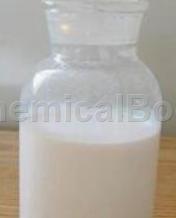Background and overview[1]
Styrene-butadiene latex is also called polystyrene-butadiene copolymer. The preparation of styrene-butadiene latex is basically done by physically adsorbing the added emulsifier on the surface of the latex particles to achieve the stability of the polymerization system and the stability of the latex product. For example, a method for preparing styrene-butadiene latex. Specifically, the method includes adding aliphatic conjugated diene, aromatic vinyl compound, C3-C5 ethylenically unsaturated carboxylic acid in the presence of anionic and non-anionic emulsifiers. Acid, vinyl unsaturated carboxylic acid ester, vinyl unsaturated carboxylic acid amide and vinyl unsaturated nitrile monomer are copolymerized.
The anionic emulsifier is two or three anionic emulsifiers selected from the group consisting of alkylphenol polyoxyethylene ether sulfate, alkyl diphenyl ether disulfonate and alkyl sulfonate, or an alkyl emulsifier. Alkyl phenol polyoxyethylene ether sulfate and/or alkyl diphenyl ether disulfonate are anionic emulsifiers; the nonionic emulsifier is alkyl phenol polyoxyethylene ether. However, no matter how it is improved, it is necessary to rely on the added emulsifier to stabilize the latex.
Although emulsifiers can stabilize latex, the addition of emulsifiers will affect the performance of latex, such as the adhesion and water resistance of latex ingredients; and, the properties of the obtained styrene-butadiene latex Stability is achieved by physical adsorption of emulsifiers, so the mechanical stability and chemical stability are poor. For this reason, domestic and foreign research institutions continue to develop new emulsifier systems, hoping to prepare styrene-butadiene latex with excellent performance under low emulsifier dosage or even under emulsifier-free polymerization conditions.

Application
The physical structure, processing performance and product performance of styrene-butadiene latex are close to those of natural rubber. Some properties such as wear resistance, heat resistance, aging resistance and vulcanization speed are better than those of natural rubber. It can be used with natural rubber and various Synthetic rubber is used together and is widely used in the production of tires, tapes, hoses, wires and cables, medical equipment and various rubber products. It is the largest general-purpose synthetic rubber variety and one of the earliest rubber varieties to achieve industrial production. Examples of its application are as follows:
1) Used to control cracks in a cement-stabilized gravel base, including: Step 1: Preparing a styrene-butadiene latex ball using styrene-butadiene latex. The styrene-butadiene latex ball is an internal structure composed of several linear connections interlaced with each other. The diameter of the hollow sphere is 0.6-1mm in the linear connection, and the diameter of the styrene-butadiene latex ball is 2-3cm; Step 2: Add the styrene-butadiene latex ball to the cement-stabilized gravel, and the styrene-butadiene latex ball and the cement-stabilized gravel The mass ratio is 0.004-0.006:1, then add water and aggregate, and mix evenly to prepare a cement-stabilized gravel mixture; Step 3: Pave and roll the cement-stabilized gravel mixture to form a base layer ; Step 4: Maintain the base layer obtained in Step 3. By adding styrene-butadiene latex balls to the cement-stabilized gravel, the final base layer can exhibit good compactness, bonding force and overall strength, thereby reducing the occurrence of cracks.
2) Preparing a protective clothing filling, including the following steps: 0-100 parts by weight of natural latex, 100-0 parts by weight of styrene-butadiene latex, 2-4 parts by weight of emulsifier, 5-9 parts by weight of vulcanizing agent, 4-6 parts by weight of zinc oxide, 3-5 parts by weight of foaming agent, 0.8-1.5 parts by weight of potassium pyrophosphate, and 3-5 parts by weight of sodium silicon fluoride, including at least one of natural latex and styrene-butadiene latex, are used. Ingredients are used to form filler raw materials; the filler raw materials are aged at a temperature of 26-30°C for 2-6 hours; the aged filler raw materials are foamed; the foamed filler raw materials are injected into the template and perform condensation; vulcanize the condensed filler raw materials; wash the vulcanized filler raw materials; and dry the washed filler raw materials. The protective clothing filler produced by the filler production process provided by the invention is lighter in weight, has better elasticity and softness, and has even internal mass distribution and stable and reliable quality.
3) Preparing latex silk quilt, including steps: 0-100 parts by weight of natural latex, 100-0 parts by weight of styrene-butadiene latex, 2-4 parts by weight of emulsifier, 5-9 parts by weight of vulcanizing agent, 4 parts by weight of zinc oxide -6 parts by weight, 3-5 parts by weight of foaming agent, 0.8-1.5 parts by weight of potassium pyrophosphate, and 3-5 parts by weight of sodium silicofluoride, including at least one of natural latex and styrene-butadiene latex, which are formulated to form latex Raw materials; mature the latex raw materials for 2-6 hours at a temperature of 26-30°C; perform foaming treatment on the mature latex raw materials; fill silk floss materials into the mold; inject the foamed latex raw materials In the mold, the latex raw material and the silk-like material are mixed and coagulated; the coagulated latex raw material is vulcanized; the vulcanized latex raw material is washed with water; and the washed latex raw material is dried. The production process of latex silk-floss quilts provided by the invention can effectively solve the problems of poor flexibility and poor air permeability of latex silk-floss quilts.
Preparation[1]
The preparation method of styrene-butadiene latex includes the following steps:
(1) In the presence of an initiator, styrene and/or butadiene, ethylenically unsaturated carboxylic acid monomers and ethylenically unsaturated sulfonate monomers are contacted in water, and the conditions for the contact The above monomers are copolymerized to form a copolymer with a particle diameter of 60-90nm, and a seed latex is obtained;
(2) Contact the seed latex, butadiene, styrene obtained in step (1) with a molecular weight regulator, and the contact conditions cause the seed latex, butadiene and styrene to copolymerize to obtain styrene-butadiene latex.
Main reference materials
[1] CN201210157969.0 Styrene-butadiene latex and its preparation method
[2] CN201710152494.9 A method for controlling cracks in cement-stabilized gravel base
[3] CN201710792318.1 Protective clothing and filling thereof
[4] CN201710791808.X Latex silk quilt and its production process

 微信扫一扫打赏
微信扫一扫打赏

